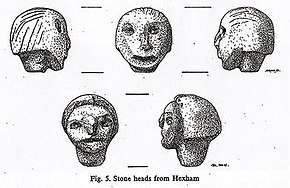Hexham Heads
The Hexham Heads were a pair of small stone heads, about 6 cm high, found in 1971 in the English town of Hexham. The heads became associated with alleged paranormal phenomena, and their exact origin is a point of controversy.

History
The heads were originally dug up by two boys, Colin and Leslie Robson, who found them in the garden in 1971; a number of sources incorrectly give the year as 1972. After the discovery, the Robson family reported strange phenomena, with the heads allegedly being moved when no one was in the room and bottles being mysteriously thrown across rooms. The Dodd family next door also reported phenomena, with one boy's hair pulled in the night and his mother Nelly seeing a half-man, half-goat figure leaving the house shortly afterwards.[1]
The heads were subsequently given to Dr. Anne Ross, an expert in Celtic artefacts. According to Dr. Ross's own account, she woke up one morning and saw a part-wolf, part-man figure walking out of the room; she followed it downstairs and saw it heading towards the direction of the kitchen, but then lost track of it. A few days later her daughter Berenice told her that, after returning home from school, saw a large, dark, werewolf-like figure on the stairs that jumped over the banisters and into a corridor before vanishing, the wolf believed to have some relation to the Hexham wolf that killed livestock in the winter of 1904.[2] Ross also reported the feeling of a cold presence, her study door bursting open with no apparent cause and another apparent sighting of a dark figure. Knowing of Nelly Dodd's experience, Dr. Ross equated all of these phenomena with the Hexham heads[3][4] and the incidents allegedly stopped when she removed the two Celtic headS in her possession out of the house.[1]
A man named Desmond Craigie reported that he was the creator of the heads, making them in 1956 for his daughter while he was living in the house later occupied by the Robson family, along with a third head which became damaged and had to be thrown away. Craigie, who worked for a company that dealt in concrete at the time he allegedly created the heads, made some replicas to demonstrate his claim, however, these replicas were not satisfactorily similar to the original heads. The original heads were analyzed by Professor Dearman of the University of Newcastle, who concluded that the items had been moulded artificially rather than carved.[1][4]
The original heads were later given to another man but him and the heads vanished and the were about are still unknown.
See also
Notes
- Ferrol, Stuart (November 2012). "In Search of the Hexham Heads, part one". Fortean Times (294). pp. 42–7.
- Godfrey, Linda (2006). Hunting the American Werewolf: Beast Men in Wisconsin and Beyond. Madison, WI: Trails Books. p. 123. ISBN 1-931599-66-1.
- Ash 1977, p. 11-12.
- Bord & Bord 1991, p. 206-8.
References
- Ash, Russell (1977). Folklore, Myths and Legends of Britain. London: The Reader's Digest Association Limited. p. 552. ISBN 9780340165973.CS1 maint: ref=harv (link)
- Bord, Janet; Bord, Colin (1991). Modern Mysteries of Britain. Diamond Books. p. 368. ISBN 0-261-66369-0.CS1 maint: ref=harv (link)
- Screeton, Paul (2012). Quest for the Hexham Heads. CFZ Press. p. 264. ISBN 1905723946.CS1 maint: ref=harv (link)